
A Mitsubishi A6M5 Zero fighter belonging to the Planes of Fame Air Museum in Chino, California was recently packed into shipping containers destined for the land of its birth, Japan. This is the third time the plane has been sent back to Japan since its restoration to flying condition in 1978.
The Zero will be on display for five months at the Yoyogi Parade Grounds in the Shibuya Ward of Tokyo, which was the site of Japan’s first powered flight when Japanese Imperial Army Captain Yoshitoshi Tokugawa made that historic flight in a Farman III biplane on December 19, 1910.
Captured undamaged on the island of Saipan on June 18, 1944, this Zero was one of 13 examples shipped to the USA for testing and evaluation. The illustrious list of pilots who flew this particular Zero includes Charles Lindberg, Marine Corps ace Marion Carl, Grumman chief test pilot C.H. “Corky” Meyer and dive-bomber pilot/post-war air racing champion Cook Cleland.
During its first trip back to Japan in late 1979, the Zero undertook a six-month flying tour around the country, the first time that a Zero had been seen flying in the Land of the Rising Sun since the end of World War Two in 1945. In 1995, the Zero, along with another of its Planes of Fame stablemates, a North American P-51D Mustang were shipped across the Pacific for a flying tour around Japan, entitled “Flying as Friends.” Though the Zero is not scheduled to fly during this exhibition, its distinctive 14-cylinder, air-cooled, radial Nakajima Sakae engine will be started from time-to-time for the expected crowds of appreciative onlookers.
For its size, the Zero is a extraordinarily difficult aircraft to ship. To save weight while retaining strength, Mitsubishi designed the Zero’s wings and cockpit as a single, non-divisable unit. For shipping purposes, this construction requires that the aircraft be broken down into three sections, from the firewall forward, the center section and wings as a single unit and finally, the fuselage and tail section aft of the cockpit.






















